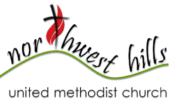(click on caret to listen to the sermon)
Series: All In – Prayers, Presence, Gifts, Service and Witness
Sermon: Prayers
Text: Luke 11:1-4
Rev. Laura Brewster
Introduction. Last week we began a new series of messages titled “All In.” These messages are based on steps we can take to go “all in” with regard to our response to God’s love and offer of relationship. Last week we focused on the need to be present in worship on a regular basis. Today we will shift our focus to prayer.
What Is Prayer? Prayer is not treating God like Santa Claus and presenting him with a wish list. It is also not a method we use to manipulate God. As its basis, prayer is simply conversation with God. It involves both speaking and spending time listening. Regular prayer strengthens our relationship with God and is essential to the life of a Christian. Martin Luther said, “To be a Christian without prayer is no more possible than to be alive without breathing.”
Jesus Modelled Prayer. Jesus was a man of prayer. Look at the following texts for examples: Matthew 19:13; Matthew 14:23; Matthew 26:39; Mark 1:35; Luke 3:21; Luke 6:12; Luke 9:29; Luke 10:21; Luke 11:1-4; Luke 22:31; John 11:41.
A Challenge to Recommit to Prayer. Too often we neglect our prayer life. Addressing our tendency to do this, Corrie ten Boom once asked, “Is prayer your steering wheel or your spare tire?” If it central to your life or seized only when deemed necessary? This week, our challenge is to recommit ourselves to making our prayer life a priority – recommit ourselves to spending time with God on a daily basis so that we can grow in our relationship with God. Begin by committing to praying each day this week. Commit also to praying five times a day – morning, before each meal, and evening.
Prayer Styles. Are you unsure of how to pray? If so, consider the following ideas.
- Simply offer God thanksgiving. By offering God thanksgiving for what is present in our lives and what is good in our lives, we are reminded of God’s faithfulness, and that in turn provides us with greater peace, joy and hope. Read: 1 Thessalonians 5:16-18 and Philippians 4:6.
- A.C.T.S. Begin by offering praise to God (adoration). Continue by confessing your misdeeds, sinful thoughts or hurtful words (confession). Next, offer God thanksgiving for your blessings (thanksgiving). End by asking God to meet needs in your life and the lives of others (supplication).
- Five Finger Prayer. Each finger on your hand represents a group of people. The thumb, which is closest to us, reminds you to pray for the people closest to you such as parents. The pointing finger represents those who point you to God. Pray for your pastors, Bible study leaders, etc. Next is the middle finger – the longest finger. This represents the leaders in our world, our nation, and the larger church. Pray that they will receive and act upon God’s guidance. Fourth, comes the ringer – the weakest finger on our hand. Pray for those who are poor, marginalized, etc. Finally, comes our pinky finger, and this represents you. After you have prayed for the other groups, you can offer up your thanksgiving and needs to God. Because you have prayed for others first, you will be able to offer your prayers with a better perspective.
- Lectio Divina. Lectio Divina is a method of praying based on the scriptures. Begin by reading a section of scripture; consider the general message of the passage. Step two is to meditate and ask yourself: what does this text say to me and to my life? Step three is to pray; engage God in conversation about the passage. Step four is to contemplate how God may be asking you to change in response to your reading.
Conclusion. “…pray always, pray and never faint, pray, without ceasing pray.” Charles Wesley
